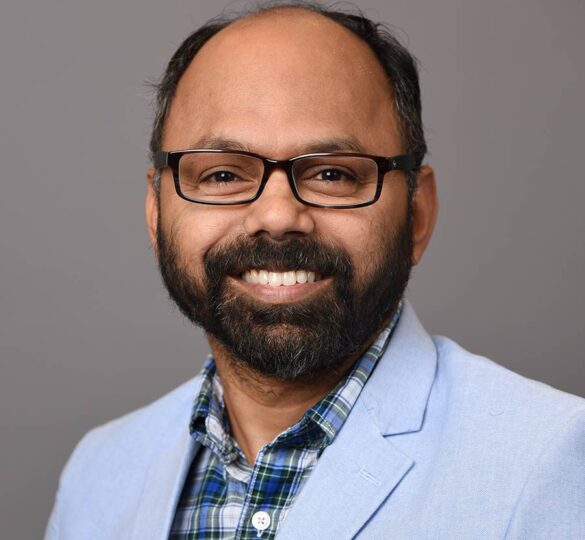Researcher Spotlight: Meet Padhu Pattabiraman
In this interview, we learn about Padhu's extensive background, his research interests, and his personal passions.

Glaucoma researcher Padmanabhan “Padhu” Pattabiraman, PhD is an assistant professor in the ophthalmology department of Indiana University School of Medicine in Indianapolis. In 2018, he was awarded a Shaffer Research Grant from Glaucoma Research Foundation for his project to study “Anti-fibrogenic Matricellular Protein CCN1 as a Novel Therapeutic Target to Lower Intraocular Pressure.” (The 2018 Frank Stein and Paul S. May Grant for Innovative Glaucoma Research).
In this March 2022 interview with Angela Hopp, executive editor of ASBMB Today, we learn about Padhu’s background, his research interests, and his personal passions.
Tell us a bit about your background and educational journey. How/why did you wind up where you are? In other words, what’s your story?
I hail from Chennai, Tamil Nadu, India. I completed my bachelor’s and master’s in biochemistry and decided to move to Italy to do my Ph.D. in neuroscience at the International School for Advanced Studies in Trieste. Trieste is a very beautiful city on the northeast coast of the Adriatic Sea.
After completing my Ph.D., I moved to Duke University to do a postdoc in neuroscience and then in ophthalmology. During my postdoc years, I studied the role of Rho GTPase signaling in the regulation of cytoskeleton-extracellular matrix interactions in a very tiny yet important tissue called trabecular meshwork.
I was a research-track investigator at Case Western Reserve University, where I got multiple grants, including my R01 from the National Eye Institute, and then moved to the Eugene and Marilyn Glick Eye Institute at Indiana University School of Medicine to start a tenure-track position in 2019.
Tell us a bit about your studies/research.
My lab strives to understand what causes glaucoma and the racial disparities tied to it. I am passionate about this area of study because it poses a considerable health challenge to the world’s aging population. The predicted increase in glaucoma cases in the future is staggering considering the impact it would have on the quality of life for people across the globe and the economic burdens it would create for governments and taxpayers. Finding a cure and alleviating pain are the major inspirations to work on these areas.
Glaucoma is the second leading cause of blindness worldwide. About 2-4 % of the U.S. population currently suffers from glaucoma, and it’s most common in those older than 40 and people of color, particularly African Americans. Currently, there is no cure for blindness, and managing it can be difficult, as early symptoms of glaucoma often go unnoticed. Typically, peripheral vision loss due to elevated pressure makes the person go to the eye doctor.
My team strongly believes that primary open-angle glaucoma, or POAG — the most common form of the disease — is a combination of biochemical and biomechanical problems within the aqueous humor drainage pathway. Aqueous humor is a watery, plasmalike fluid produced within the eye that helps to nourish and cleanse the anterior portion of the eye. It’s drained predominantly through a tiny tissue called a trabecular meshwork that runs 360 degrees around the eye. But if this tissue becomes clogged, it leads to elevated intraocular pressure. Sustained intraocular pressure can cause compression on the retinal ganglion cell axons, which retract and eventually die.
My lab studies the significant knowledge gaps in the contribution of the actin and ECM in the regulation of outflow resistance
What else are you passionate about? What do you do in your spare time?
The other passion that I have is photography. I love taking pictures with my Canon of nature as much as human subjects. My favorite is night photography because it is very challenging. I love watching and playing cricket and football (soccer) and enjoy college basketball. I support the Indian men and women cricket teams, and Italy is my favorite football team. Duke is my favorite College basketball team. Bleeding blue all the way.
Anything else you’d like to share?
This pandemic has robbed students and postdocs of chances to attend meetings for the past two years. I can’t wait for my student Ting Wang to attend her first in-person meeting. I am excited and cannot wait to listen to her present her work.
—
Reposted with permission from ASBMB Today